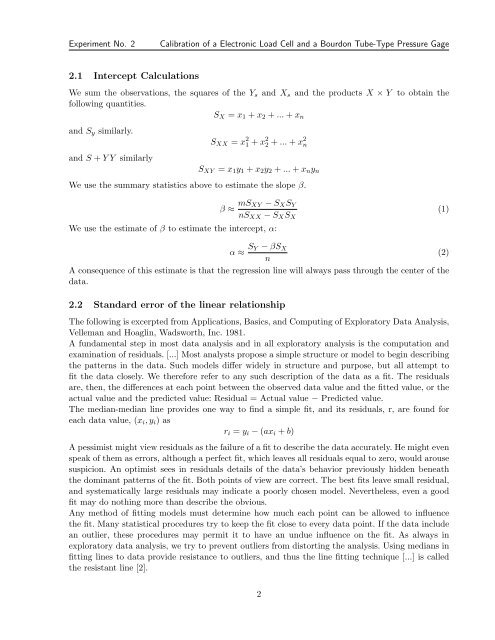Engineering Instrumentation and Measurement Experiments
Engineering Instrumentation and Measurement Experiments
Engineering Instrumentation and Measurement Experiments
Create successful ePaper yourself
Turn your PDF publications into a flip-book with our unique Google optimized e-Paper software.
Experiment No. 2 Calibration of a Electronic Load Cell <strong>and</strong> a Bourdon Tube-Type Pressure Gage<br />
2.1 Intercept Calculations<br />
We sum the observations, the squares of the Ys <strong>and</strong> Xs <strong>and</strong> the products X × Y to obtain the<br />
following quantities.<br />
<strong>and</strong> Sy similarly.<br />
<strong>and</strong> S + Y Y similarly<br />
SX = x1 + x2 + ... + xn<br />
SXX = x 2 1 + x 2 2 + ... + x 2 n<br />
SXY = x1y1 + x2y2 + ... + xnyn<br />
We use the summary statistics above to estimate the slope β.<br />
β ≈ mSXY − SXSY<br />
nSXX − SXSX<br />
We use the estimate of β to estimate the intercept, α:<br />
α ≈ SY − βSX<br />
(2)<br />
n<br />
A consequence of this estimate is that the regression line will always pass through the center of the<br />
data.<br />
2.2 St<strong>and</strong>ard error of the linear relationship<br />
The following is excerpted from Applications, Basics, <strong>and</strong> Computing of Exploratory Data Analysis,<br />
Velleman <strong>and</strong> Hoaglin, Wadsworth, Inc. 1981.<br />
A fundamental step in most data analysis <strong>and</strong> in all exploratory analysis is the computation <strong>and</strong><br />
examination of residuals. [...] Most analysts propose a simple structure or model to begin describing<br />
the patterns in the data. Such models differ widely in structure <strong>and</strong> purpose, but all attempt to<br />
fit the data closely. We therefore refer to any such description of the data as a fit. The residuals<br />
are, then, the differences at each point between the observed data value <strong>and</strong> the fitted value, or the<br />
actual value <strong>and</strong> the predicted value: Residual = Actual value − Predicted value.<br />
The median-median line provides one way to find a simple fit, <strong>and</strong> its residuals, r, are found for<br />
each data value, (xi, yi) as<br />
ri = yi − (axi + b)<br />
A pessimist might view residuals as the failure of a fit to describe the data accurately. He might even<br />
speak of them as errors, although a perfect fit, which leaves all residuals equal to zero, would arouse<br />
suspicion. An optimist sees in residuals details of the data’s behavior previously hidden beneath<br />
the dominant patterns of the fit. Both points of view are correct. The best fits leave small residual,<br />
<strong>and</strong> systematically large residuals may indicate a poorly chosen model. Nevertheless, even a good<br />
fit may do nothing more than describe the obvious.<br />
Any method of fitting models must determine how much each point can be allowed to influence<br />
the fit. Many statistical procedures try to keep the fit close to every data point. If the data include<br />
an outlier, these procedures may permit it to have an undue influence on the fit. As always in<br />
exploratory data analysis, we try to prevent outliers from distorting the analysis. Using medians in<br />
fitting lines to data provide resistance to outliers, <strong>and</strong> thus the line fitting technique [...] is called<br />
the resistant line [2].<br />
2<br />
(1)


